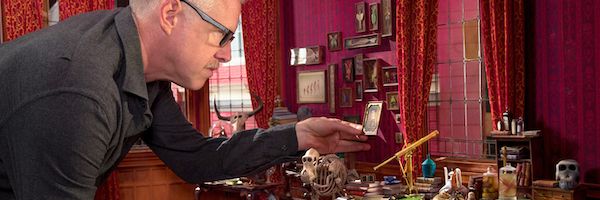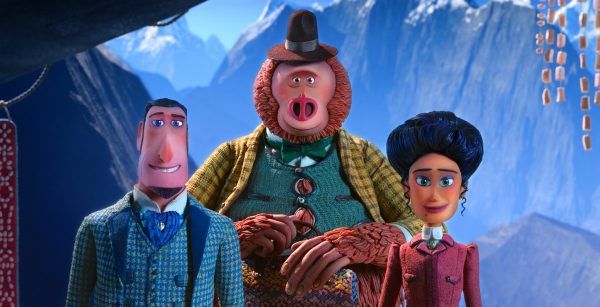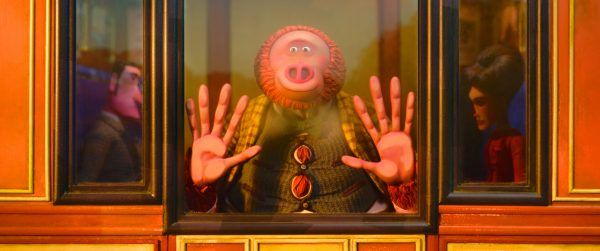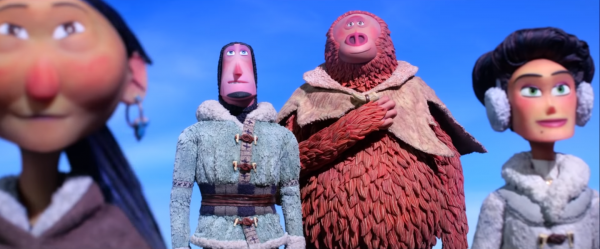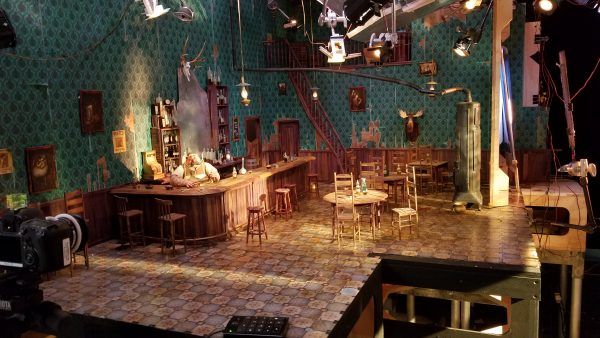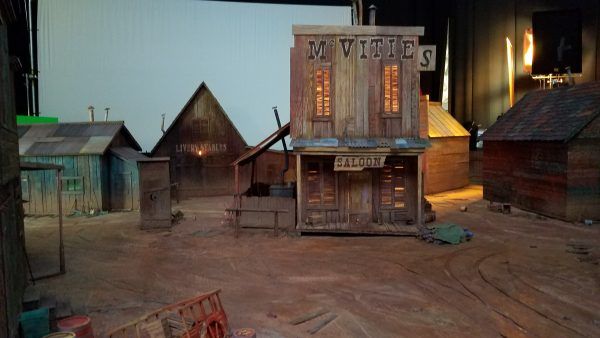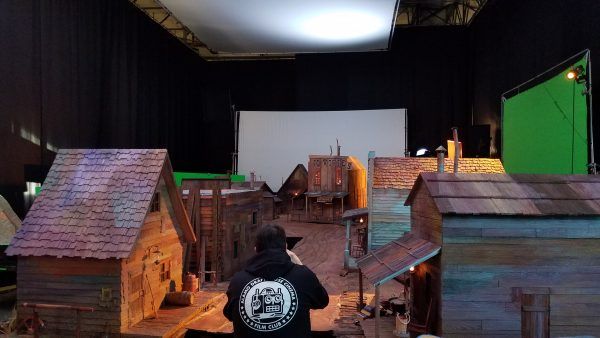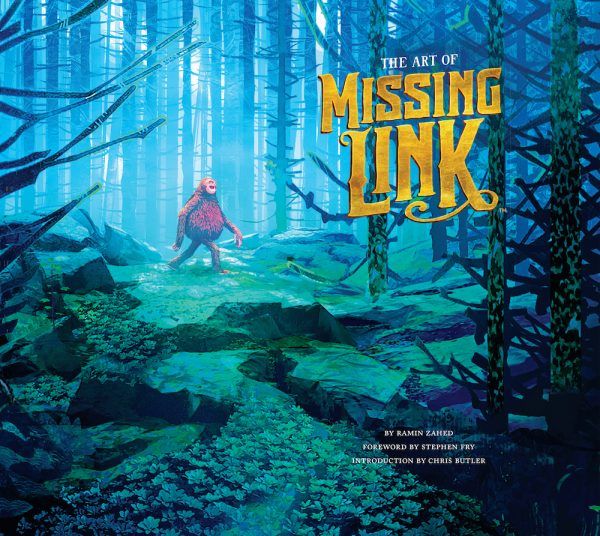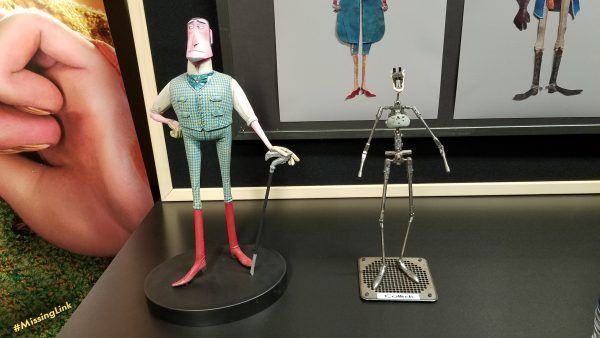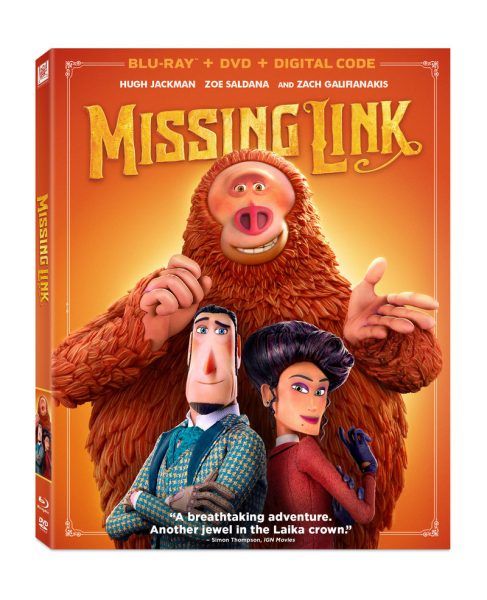Listen / download here:
We recently had the pleasure of revealing an incredible 360° video for LAIKA's Missing Link that took fans around the world onto--and into--the set of the stop-motion marvel's Wild West saloon. That video, which gives viewers unprecedented access to an actual set from the movie, including everything behind and in front of the cameras, was narrated by the film's production designer Nelson Lowry. We had a chance to chat with Lowry, a longtime stop-motion animation artist and LAIKA veteran, about his career and his latest awards-nominated work.
Lowry talked about the particulars of his job as a production designer and the many responsibilities that come with it. He also talked about how much he liked the interactive video, not only to give fans access to the set and the freedom to explore it however they want, but also because it removes the barriers of time and space between the LAIKA artists and their fans. And those fans will want to pay special attention since Lowry teases a bit about the stop-motion studio's next movie, calling it "fundamentally different" from anything they've done so far. Check out the audio above, or read along below:
First of all, thank you for speaking with me today about Missing Link and your work at LAIKA, as well. For our readers and our listeners out there who maybe don't know exactly what a production designer is, how would you define your role?
Nelson Lowry: Well, a production designer works pretty closely with the director and they lord over the look and feel of the film. So, the director writes the script, well sometimes, and directs the storytelling, and I create the visuals for behind that. And basically, I do kind of everything: It's environments, I'm involved with the characters, I work alongside a wonderful costume designer, and I go from the beginning of the film all the way to the visual effects and to the final grade of the film.
For stop-motion animation, which you've had quite the career in, not just with LAIKA but beyond, correct me if I'm wrong, but a production designer's job, it seems exponentially more difficult than, say, your traditional live-action TV series or movie because you quite literally have to have a team create everything from scratch. There's no on-set shoots or anything like that, so do you like that challenge?
Lowry: I must like that challenge because I've been doing it for awhile. I had done theater and some live-action film, and I was drawn to stop-frame for a bunch of reasons. One, I grew up in a artistic family and my mom and dad both dabbled in miniatures, so I definitely had it in my blood. But what is sort of a deadly blessing about it for me is the, you get to design everything and you get to design everything.
So, you're right about that, nothing comes for free, so on one hand, you're designing architecture and the next you are designing the dirt and then the shape of the smoke coming out of the chimneys and the leaves on the trees. Yeah. So, your list is long, and part of the thrill, for me, is keeping it very cohesive. So, early on, establishing visual tenets for the film that reflect, usually, the character design and then making sure that every frame is imbued with that logic.
And you've been with with LAIKA for a quite a few films now, so over the years, how has your role changed? Has it been aided with better technology or do you still have challenges based on what the filmmakers are asking for?
Lowry: I'd like to say that, in a normal situation you might be able to rest on your laurels a little bit, and I guess, to an extent, at least my confidence is stronger because I've done it before. But because Travis Knight, who's the owner of the company, his mandate is each film has to be bigger and more special visually, and he wants to push technology. I mean, Missing Link, for example, I read through that script and basically it changed location every page and a half, which is extremely unusual. I mean, usually you get to rest for a minute or hang out in a location, and the thing about that is, let's say you design a town and there might be many locations within the town, but it's the same town so you get to reuse. But with a script that goes around the world, each new location requires a whole new set of research and look and feel and making them feel different from each other. So, I went from ParaNorman to Kubo to Missing Link, and each one just exponentially seemed to get bigger. So, I would say that's the biggest challenge is just keeping up with the expectations of the studio.
I know you guys are always in different stages of production for various things because it takes a while to make these movies. So, if you could think to your busiest time in the movie season, what does a typical day look like for you at the peak busy season?
Lowry: Oh, it's pretty busy. I mean, I can't really complain about it because so many other people are that busy, too, but I will say it's pretty crazy. I'm usually still working on designs for the third act during the shooting, and when I open my calendar in the morning, I see that often it's divided up into about 15 minutes slots for about eight or nine hours and often working through lunch. So, it's extremely detailed-oriented and I have to be prepping for the next meeting and paying attention to what it is that I really have to solve in that moment. So, it's a little bit of an adrenaline thing. I do love it. I will admit, I sleep in my office at lunch sometimes, but that's at its most extreme.
I often say that these films, they're long-distance; they're not sprinting. I warn all the younger people when they're really giving it their go at the beginning I'm like, "You're going to be doing this, working as hard, a year and a half from now with no break," so you have to really... It's fast-paced but you also have to pace yourself. And the other thing I think is interesting because we are, essentially, building practical, almost live-action, sets, your decision making has to... you have to be very confident in it because you are making decisions that will be built, and the next time you see them they're going to be on a stage and you can't do much to it at that point. So, you have to get used to committing to visual ideas, and that's slightly different than digital work, which we also do here and I also enjoy quite a bit, but it is a different discipline.
How does that differ for you? The practical, hands-on, talking with the costume designers and the physical practical effects work versus then having to translate some of those things to the digital side, how do those two roles work for you?
Lowry: Well, actually, here at LAIKA, I'll say it's similar only in so much that, we have a great advantage of having all the departments under one roof. Well, I mean two buildings but same location. And so, the digital effects team is different, I would say. Like in a live-action film, you would hire a couple effects companies and you would liaison with them and they would have their own internal structure, but our VFX team is very hands-on, very creative, works very closely with the art department. So, they start early on and we go back and forth a lot. When they need a texture or need to scan a maquette or something, we can build that for them on the spot. So, it's surprisingly similar to a physical build.
That's what I noticed with our effects team. It's very practical kind of stuff. What you see is what you get, and even though they are using all this amazing new software, they really lean heavily on the art department to supply them with the visuals that they need. And it's kind of, I mean, no pun intended, it's kind of Shangri-La. And it kind of needs to be because we do a lot of extensions, and for me, I don't like when you're watching a film and being like, "Oh, that's where the set stops and the digital begins." I think we do pretty good. I mean, it's hard to do, but we do pretty good at making it feel like one big world.
We had the pleasure of revealing a 360-degree video of one of the sets for Missing Link, which you narrate. It's absolutely incredible, and it touches on everything we've talked about today; it highlights all those different aspects of the production. So, what can you tell us about this set that you remember, if there were any particular challenges that it posed, or what made it a great example for a 360-degree video like this?
Lowry: Well, I think, the size, to start. I mean, the subject is great. I love that set. I had a great time working on it, and I think it's very beautiful. It was a tricky thing to do because Chris Butler, the director, wanted it to be quite ugly but also beautiful, so it was kind of fine line but the size of it is pretty good, I think, for 360 because it is a contained space, the set itself is probably only five by seven or eight feet. And what I love about that 360 video is, there's lots of cool things about building all this stuff, but when you give tours, people just, their jaws drop when they come into the studio and they go into units and they see, "Wow, I'm in this world."
It's so childlike because you're actually seeing, almost like what you might've set up when you were playing with toys as a kid or playing with your kids and imagining these places. But now, you can physically go in it, and I think the 360 video lets the viewer participate in that way and pursue right into that spot. So, it's the closest thing I've seen to actually getting a tour on one of our stages, for anybody who's interested. And I hope we do more of it because I know that in that 360 we're calling attention to details and things, but what I would really encourage people to do is just ignore that and look at whatever they want. That's the whole point of it. You're in control, and you can check out the ceiling. Like, where are people going when they go off camera? Well, you get to see them leave the actual unit. Yeah, it's a very good "I'm there" kind of experience.
I love both of those aspects that you mentioned. One, is you get to like physically look in and visit the set as if you're actually there, but then, for people who are interested in the nuts and bolts behind the scenes, you get to turn the camera around back on you guys and your team as you go about your work. And you get to see the people who are actually making this stuff come to life, which you never get to see.
Lowry: Yeah. And also, the sets and characters and costumes are all beautiful, we're very proud of them, but also, they don't just film themselves. I mean, the crew and the dressers and the lighting, the camera, I'm not just saying this; we admire them so much and it's a chance for their work to be seen, as well. And one other interesting thing about that video, I think, is if you [tilt] up and see all the practical lights and the stands and the flags and there's, without exaggeration, probably 50 or 60 pieces of equipment hanging up there, and then you think, at the peak of production, we're shooting on maybe 60 units. So, whatever you see there, it's times 60 with a higher production or more. I mean, we have a hundred units shooting, but I'm saying, really, like set up and ready to go units, so you have to imagine a whole studio filled with stages like that. It's just a crazy thing.
That's incredible, and I've had the opportunity, the blessing, really, to visit a number of LAIKA productions and actually take those tours with you and your team. And I remember walking onto the sets of Missing Link, and there are still things in this video that I would not have picked out unless it was brought to my attention from you or your team members, like the specific design of the wallpaper or the fact that the tiles were hand-sanded and distressed to make it look like there was wear and tear on it. I love this video for things like that and bringing that to attention to casual viewers and to super-fans out there. I thought it was great.
Lowry: Yeah. Good. I really appreciate your kind words because we're obviously... people who do this work are super passionate about it, and I love it. It's nice to hear that other people outside the studio are excited and appreciate it, specifically what we do, because it's nice. It's also really great giving tours because you think... It does become a little bit of a job at some point, and when we're giving tours, you get to be excited with... You almost get to see it for the first time on someone else's account, and you're like, "Hey, this is actually pretty cool." It's not just stressed and running around, it's we're making cool stuff, so I think this video is a extension of that.
So, with videos like this, and with tours, you're kind of limited in scope. You can't just bring everybody, billions of people around the world in for your tours, but what else do you think LAIKA could, or maybe has plans to, reach out to really highlight the incredible amount of work and artistry that goes into each of these frames? Because honestly, and this is just my opinion, but I think, sometimes, people see the seamless animation from LAIKA and they don't really realize that it's stop-motion, that it's frame by frame, that it's handcrafted puppets and sets and costumes and creatures and vehicles. How do you educate them?
Lowry: Well, that's always been our intent, and with things like this video, it's on your site, so, people having access to that. And also, we did a great museum exhibition here at the Portland Museum of Art, which was the most highly attended show that they've ever had. It had lines. It was amazing. And I really encourage people, if they're lucky enough to be able to go to Comic-Con, when we have a film coming out, we set up pop-up shops and we break these sets down and send them all around. And we're going to do more of that, but I would really encourage people, also, to go out of their way to go and see these things because they're beautifully displayed when we do it and you get to get right up to close, you can linger as long as you want and check stuff out. So, we're just trying to do more of that and bring awareness to our process.
Absolutely. And there's a great art book out there from Insight Editions, as well, that goes behind the scenes of, specifically, Missing Link, but other other movies as well, so that's a great resource for people who are interested out there.
Lowry: Definitely.
So, looking back at 2019, it's been an interesting year for puppets of all different kinds. We've got Missing Link, there was The Dark Crystal prequel series, and now everybody's obsessed with Baby Yoda. So, what do you think the state of puppetry is in entertainment right now, and where do you think the future might be headed?
Lowry: Well, I think, like all mediums, I think it ebbs and flows. I think we're having an absolutely like a Renaissance, when you think about... We're well on our way with film six here at LAIKA, in our same Portland city. There's Guillermo del Toro is working on Pinocchio, which is a stop-frame film. Also Henry Selick is working on Wendell and Wild here. So, in in this city alone, thereare three stop-motion features going on. I'm sure that the attention and interest in Dark Crystal is going to, probably hopefully, bring us more. So, it does seem to be, people have an interest in it. Again, digital work, I love this work. I have done it myself, but there is something, I think, that people connect with and they love watching the making of it and behind the scenes of these things. And I think there's some more of an interest generally from people in the filmmaking process. So, yeah, I hope it just keeps going.
And speaking of keeping going, you mentioned the next movie from LAIKA. Was there anything that happened during the production of Missing Link that you were like, "I can't wait to use this or implement this or try this on our next project"?
Lowry: Yeah, there was. Thank you for asking. So, of course, I can't say anything about it. I'll choose my words very carefully, and I don't want to just sound like a cheerleader for the company, but I will say the next film is so different, fundamentally different, from the things we've done and really takes everything we've learned and just doubles down on them and showcases these new technologies that we're getting pretty good at. So, it's not just bigger and better, it's more clever use of, and it's just going to open up, I think, the vision for the studio in a way that people will be quite surprised. So, I know that's a giant tease, but I'm very serious about it.
Is there anything else that you're currently working on that maybe isn't LAIKA related or does it pretty much take up all of your time?
Lowry: No, I'm a very obsessive working artist. I go home, I have a studio at home, and I make characters and design sets and build things all the time. It's my passion. So, yeah, I do a lot of really crazy cool stuff that's all my own, and I hope to do something with that someday. So, thanks for asking.
Well, with how labor intensive, the LAIKA feature films are, I know companies, obviously, like Pixar and Disney Animation have been encouraging their creative teams to come up with ideas for shorts, things that they could produce. Does LAIKA have any plans to do anything like that, or would you like to see more opportunities for stop motion shorts?
Lowry: Well, of course I would. Yes. I do think, just to be realistic, I mean, hell I would love to make a short, but I will say though, the one thing that's a little challenging is when we're making a feature, it's really all hands on deck. We don't have really giant crews. I mean, I think you'll notice, if you look at the products on our films, they go by pretty quick compared to the other larger studios, and so we just don't have that overhead of this people available to be able to work on things. But that doesn't mean we don't have some tricks up our sleeves. I mean, we are definitely looking ahead, looking to what other kinds of things we can do. I do think LAIKA is... I know we've been around for a while and made a lot of films, but I think we're looking to do a lot more. So, I'm enjoying my time here. It's the longest I've ever been in a company, and I'm quite happy here, which I think says something because I have wanderlust but this place keeps me always guessing and busy.
Before I run out of time with you today, congratulations on both Annie Award nomination for you specifically and the number of awards nominations for the film itself. What does that mean to you personally? And then, if you could speak to, maybe, your team, as well.
Lowry: Oh, what a great question. Well, I'm going to give you an honest answer. When I was younger, I was just like... I don't know really how to describe it. I was like, "Awards don't matter," and boy, did I change my tune because I mean, really, when you're recognized by your peers and you go to these award ceremonies, it doesn't matter if you win or lose, you get to hang out with people you don't have to apologize for being such a geek and loving this stuff so much. And so, you're at a table with people, just explosive conversation of creativity and talking about stuff. It is so fun, and I'm so excited that we were nominated.
My team, the design team is, again, I'd say it's very small. There's really three or four of us, which is pretty extraordinary. And they're hand-picked. It is extremely collaborative. I know that I steer the ship, but I'm so open and grateful for their contributions. So, what you see when you see the designs of our films, it's me and I do some of the artwork, but it is really that team. I could never do that on my own.
Unfortunately, I think that's about all the time I have today, so thank you again for your time. Best of luck this award season and definitely best of luck going forward with the next project. I can't wait to see more about it.
Missing Link is now available on Digital, 4K, Blu-ray, and DVD. It's currently nominated for Best Motion Picture - Animated for the Golden Globes and has nine Annie Awards nominations, including Outstanding Achievement for Production Design in an Animated Feature Production.

